Coincidently Justin Bovington (avatar Fizik Baskerville) from Rivers Run Red invited me to join the beta trial of Vodafone InsideOut in Second Life on a day I really wanted to send messages from Second Life to all my friend’s “real” life mobile phones.
I wanted everyone to know that I was spending Saturday as my avatar Tara5 Oh standing in an avatar chain in Second Life to demonstrate for peace and justice in Myanmar (Burma). I was eager to ask my friends out enjoying the autumn weather in New York City to come and join me when they could in Second Life (see my previous post).
In the picture above I’m picking up my HUD from the Vodafone dispenser in Second Life. I’m wearing my T-shirt calling for the freedom of Burmese leader, Nobel Prize Winner and pro-democracy activist Aung San Suu Kyi.
I received a stream of useful URLs and ways to help the Burmese people from other Second Lifers at the peace demo. And, while I was there, I wanted to connect directly with my friends in real life as my avatar in Second Life. This is what Vodafone’s InsideOut is all about.
You can sign up here to join the beta trials and learn more about Vodafone InsideOut which “will allow you to communicate between virtual worlds and the real world via your mobile.”
Ingmar, Head of Technology for RRR, explained:
The service which has just come out of closed beta allows you to call and text in an out of Second Life. You get a HUD object (and a handset which is just for show and plays animations while you are on the phone.
You must sign up on the web page with your real mobile number and get verified. From then on you can call other users with your HUD, or text message them. If they are online, they get it on their HUD, but if they are off line they get the call or text on their mobile phone. The message/call comes from a virtual phone number, which hides your real one to keep your privacy. They can call or text the virtual number back at any time they want from their phone.
The virtual numbers assigned for the beta trial next week are from a German pool (+49) and, since it’s not restricted to users on Vodafone’s mobile network, when you call these your mobile network operator will charge you for whatever they charge for a call to Germany (based on where you are located in the world).
On the upside, for the beta trial the service will be free when used from Second Life which means free international calls and texts. We suspect some people will get a Second Life account just for that

The Second Wave in Second Life – Convergence and Relevance
Justin Bovington of RRR (a.k.a. Fizik Baskerville) spoke to me about Vodafone’s InsideOut project. RRR is working closely with Vodafone to bring the InsideOut to Second Life and other virtual worlds. Justin explained:
This is the start of Second Wave projects – the business tool world – convergence and relevance.
Open source is more than just a programming term, it should also apply to our thinking in terms of how we approach virtual world projects taking aspects of legacy systems [in this case Vodafone mobile communications], relevant technology and proven ways of working into Second Life will be the measure of future success.
InsideOut is very much about that. We’re not replacing the mobile phone. By trying to create a metaphor we’re using your real life moby as part of the experience. This is true convergence. Exciting stuff!
The emphasis has been on ‘modify the browser’, rather than looking at the bigger picture of integration. Open source is a call to action, not just a nerdy way to create cool interface changes. Integration is part of that message.
We’re seeing it more and more in relation to companies now viewing SL as a logical extension to their collaboration. We think that Vodafone is another level of validation in the same way Adidas did last October with the first true global brand presence [in Second Life].
I have written a lot in this blog about open source as a concept that is vital to develop “an operating system for planet earth.” And I have elaborated on how real life and second life integrations are paving the way for Second Life to play a big role in positive global development. I have argued that such integrations of open virtual worlds like Second Life will produce business and community applications that not only transform current modes of industrial production and design but are one of the keys to a sustainable future.
Integrating First Life and Second Life
There were other important landmarks last week for an increasing convergence and relevance between first life and second life.
Newt Gingrich, the former Speaker of the U.S. House of Representatives, spoke at length in Second Life on the important role he saw Second Life playing in domestic/global politics and civil life. You can find a full audio feed on the Clear Night Sky blog. It is rather ironic that a conservative should be one of the first major public leaders to come to Second Life to talk about the relevance of Second Life to “real” public life. Adding more weight to his words was the fact that he had actually engaged in the experience of being an avatar. He drives his own avatar and is knowledgeable about many aspects of Second Life (for more on this event, brought to Second Life by Clear Ink, see Reuters “Second Life Ready For Prime Time at Ginrich Event” and Rik Riel).
Public figures engaging with Second Life and innovations like InsideOut that allow Second Lifers to engage more fully with public life are certainly important markers of a Second Wave of relevance and convergence.
As with all technologies, the uptake of InsideOut by Second Life residents is sure to produce many creative and unexpected applications. And in Second Life especially because of the emotional bandwidth the experiential is a vital to understanding the possibilities for innovation in SL.
Certainly, for me, Justin’s words took on more significance as I stood in the avatar chain in Second Life thinking of all the ways this InsideOut HUD could enhance the already powerful experience of participating in something very close to my heart on Second Life that is showing my solidarity for the monks and people of Burma.
Creating an API and integrating Mobile Phones with Second Life
Another topic that I have written about on Ugotrade frequently is the important role mobile technologies have played in positive global development particularly in Africa. Also an underlying theme of Ugotrade is my hope that access to the global virtual economy and the immersive 3D space of virtual worlds like Second Life will be possible in all parts of the world soon.
I discussed with Philip Rosedale at SLCC the possibilities for the integration of mobile phone technologies with Second Life and how that might create new ways for people to access, participate, and benefit from the virtual economy of Second Life. Along these lines I had many questions for Rivers Run Red on how they had accomplished the integration for InsideOut.
I also wanted to know whether InsideOut was likely to expand into even more applications including a bunch of OutsideIn ones! Justin kindly introduced me to RRR’s head of technology Ingmar so I could discuss all the issues of integrating the mobile space with Second Life.
Prior to RRR Ingmar was working as an IT security consultant in Germany. “He started using the internet before web-browsing became widely accepted and has an extensive background in networking, security and system administration. Ingmar discovered Second Life in June 2003 and became immediately fascinated by it. He spent much of his time contributing to user created scripting documentation at http://lslwiki.net and creating interactive content in Second Life.”
I asked Ingmar a number of questions about the design of the API. I asked about how they had overcome some of the messaging bottlenecks that I frequently hear are an obstacle to developing APIs to SL.
We’ve designed and implemented an API together with Vodafone for both calls and text messages and all the other stuff we needed like account status and channel registration (so it keeps working when you go into another sim). All information exchange is encrypted and signed and the Vodafone servers are using Verisign SSL certificates to ensure we only connect to the authentic ones

The messages are near real-time, we just don’t need to send a whole lot of data, as SMS messages are fairly short in nature so bottlenecks with that weren’t that much of a problem (although they are for some things like contact storage).
LSL memory limits where a much bigger issue to the point were we couldn’t add some features we wanted because even with splitting the HUD up in a lot of scripts we eventually reached the point where the main code grew too large in bytecode size alone.
Securing Second Life: Will mobile phones be a gateway to virtual banking in Second Life soon?
I asked Ingmar what he saw in the future for Outside In applications for mobile phones and Second Life. And what were the challenges to making mobile phones an interface to virtual banking in Second Life? Re the second question issues of security are of course paramount. Ingmar began by pointing out that the introduction of Mono will make big differences for securing data messaging in and out of Second Life.
But the other major issue is that any bank (and all users) are trusting Linden Lab not to interfere – since Second Life currently runs on their servers. [I have written re LL ‘s intention to allow “trusted” providers to run Second Life on their own servers here.]
Mono is no manna from heaven. But it will hopefully help with the current limitations of LSL in that it will be faster and allow more memory – which is what’s currently limiting security because you can’t even fit a modern algorithm into LSL.
But you managed to do this project on LSL?
LSL is actually quite cool for what it is. I think this is one of the most complex items done in LSL
The amount of linkmessages it uses internally is staggering (it spams you horribly when you actually make them visible).
Mono just runs bytecode so you have to have a compiler that converts any language to mono bytecode. I think LL was definitely intending for LSL to be one of those languages, and another hopefully will be Python.
Did you use Python for this?
No the backend is written in PHP. Personally I prefer Python but I did not write the backend, a Vodafone tech (Bruno Rodrigues) did. And we designed the protocol/API together. RRR did consulting work on the development of the backend (like explaining why some stuff should be done on the backend, because it’s such a pain to do it in LSL), but obviously left the telecomms stuff to them (things like integrating SMS messaging and calls).
Are you thinking of developing some OutsideIn project, e.g., mobile dashboards for SL?
Hm, interesting idea, but that’s really the opposite direction – bringing SL onto mobile devices. I can’t really talk about that at this time


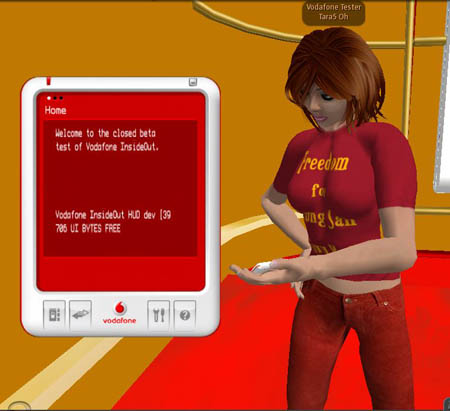
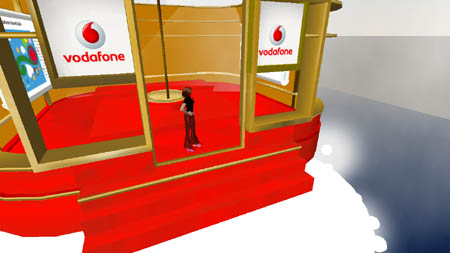
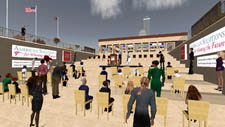
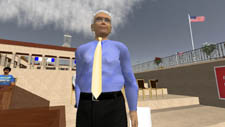
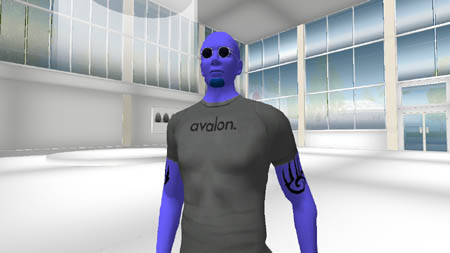
October 1st, 2007 at 2:26 pm
Free Burma!
International Bloggers’ Day for Burma on the 4th of October
International bloggers are preparing an action to support the peaceful revolution in Burma. We want to set a sign for freedom and show our sympathy for these people who are fighting their cruel regime without weapons. These Bloggers are planning to refrain from posting to their blogs on October 4 and just put up one Banner then, underlined with the words „Free Burma!“.
http://www.free-burma.org